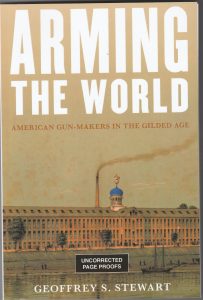By Geoffrey S. Stewart
Hard back 314 pages $39.95 + $5 Shipping
Available from Rowman & Littlefield 1-800-462-6920
Email: customercare@nbnbooks.com
We all know the basics of the history of American gun making but few have seen all the fine details.
That’s where this book comes in fleshing out the abbreviated narrative into the complete story.
And what a story it is. How a small former colony grew and introduced interchangeable parts and mass production to the world. This book tells how and why it came about instead of saying it just happened. From government armories to private factories America was embracing the new technology in guns that became the Industrial Revolution as its technology was applied to making every item.
American mass production machinery and guns were being exported to eager buyers overseas. American gun designs led the way as other American inventions began to make their mark on the history of the world. Without them the great colonial powers of the 19th Century could never achieved the heights they did for it was the superiority of their weapons that gave them mastery over the savage natives in the lands that they wanted to colonize just as it was the superior weapons of the white man that vanquished Native Americans.
The fascinating stories of the great 19th Century American arms makers and their foreign sales and intrigues and the use that their customers abroad made of their American arms is the story of 19th Century expansionism and defined Western civilization as it spread abroad to dominate the most distant parts of the earth.
It’s one thing to relate the events but quite another to provide all the fine details. That’s where this book comes in, giving an in-depth knowledge of all the factors that figured in the historic events that shaped the history of gun making in the U.S. which went on to influence events worldwide with a legacy and ramifications that continue to the present day. This is an entertaining read that will give you a far greater understanding of these events and how they are all tied together than any previous work that I have come across.—Jim Dickson




